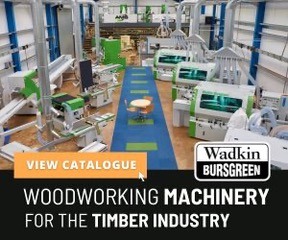Traditional Sash Windows, based in Guildford, Surrey, has been manufacturing, supplying and installing traditional sash and casement windows since 1999. During this time, the firm has completed a large variety of installations, supplying over 50,000 replacement windows plus refurbishing existing sash windows.
Traditional Sash Windows is very much a family business, started by chairman Paul Kitching, and run by Matthew Lord, managing director, and Jamie Kitching, director. With their close-knit team they are responsible for the growth and day to day running of the business.
As the business is flourishing and production volumes are increasing, at the beginning of 2014, it was decided to examine the purchase of a CNC machining centre, as its existing SCM Windor 20L, although still producing excellent window and door components, was not capable of grooving, bevelling and machining horns, draught excluding strips and security bolt locations.
It was felt a CNC machining centre, with a five-axis routing head, would machine all window and door components in one location on the CNC’s table, avoiding loss of datum when moving components from one machine to another, providing greater accuracy and a better machined finish.
Therefore, a visit to SCM Group’s CNC manufacturing unit in Rimini was arranged by SCM UK’s area sales manager, Mike Lee. An Accord WD cell was demonstrated that also includes an automatic component feeding and stacking facility.
The Accord WD can be used for production in batches and in single units without ever interrupting the work cycle and always feeding at the maximum speed.
The Accord WD is easy and fast to use and also with manual loading to produce any type of component and therefore exploit all the potential of an SCM machining centre. The automatic component movement system and the worktable management ensure that the continuous presence of the operator is not necessary.
The five-axis machining unit, designed and constructed specifically for demanding jobs, is supported by a rigid mobile gantry-type structure for fast profiling of large section elements. The table/machining area is 6360 x 1905mm.
The work cycle is never interrupted as while the machine is machining on one half-table, the finished components are unloaded from the other one and new ones loaded. Machining special door and window frames or other types of products is extremely simple as the worktable can easily be accessed for manual loading and unloading.
The powerful 13kW, five-axis Prisma T machining unit, designed and constructed specifically for demanding jobs, ensures profiling of large section elements with fast feed speeds. SCM’s electrospindles, with HSK 63 E tool holder fixing, are powerful and reliable. They allow the use of tools of large dimensions and with double profile ensuring ease of profiling on elements of a large cross section.
A Rapid 12 tool-changer is adjacent to the five-axis head and in addition, a 48 station TRC rear tool-changer can accommodate large dimensioned and heavy duty cutting heads.
Cutting, routing and boring, both vertically and horizontally, without needing the tool-changer – using the 3kW machining unit type BRC. Fast and precise for all accessory machining, and for making a door or window frame, there is a single secondary unit using an independent Z axis and dedicated inverter.
The twin spindle horizontal head can be used for door hinge and lock recessing. A two spindle boring unit and a sawblade unit.
Matic is the fully automatic worktable ideal for machining solid wood. With complete set-up in seconds, all bars and supports moving simultaneously, and each driven by an independent motor. The many technical devices give this table lasting safety and reliability.
It is perfect for machining pre-finished/finished door and window frames, all supports having cleaning blowers which remove shavings from the sliding zone and on the component hold down base during changes of the clamps.
Automatic feeding of the components from the infeed buffer (upper table) by the left robot arm deposits the components on to the left side of the CNC’s table. While the CNC executes the program on the left table, the right robot arm receives the next components from the rear roller conveyor and deposits them on to the right side of the CNC’s table.
Once the program is finished, the left robot arm unloads the machined components from the left table and deposits them on to the unloading buffer (lower table).
The cycle is completed by unloading the components from the right CNC table while the CNC continues to machine the next components on the left table. Several components, of different length, can be positioned on the loading buffer.
When the operator loads the component, its dimensions – length, width, thickness – are checked by an optical sensor. For increased productivity, two components can always be machined at the same time on the CNC’s half-table.
Short components are loaded automatically and clamped with a single clamp. The handling units are positioned with NC controlled axes. The clamping devices are positioned automatically, according to the length and width of the components.
Maestro WD parametric software was developed by the SCM Group to design and produce door and window frames on machining centres. It supports the design requirements of the most common types and geometric shapes of door and window frames, both linear and curved. A simple and intuitive graphic interface guides the user through every step of the project all the way to creating the machine programs.
Paul Kitching concludes: “We are very please with the SCM Accord WD and can see the benefits of the machine, especially the quality of the finished components and the machining of rounded edges. At the moment we are set up for sash window production and eventually we will move on to door production.”








